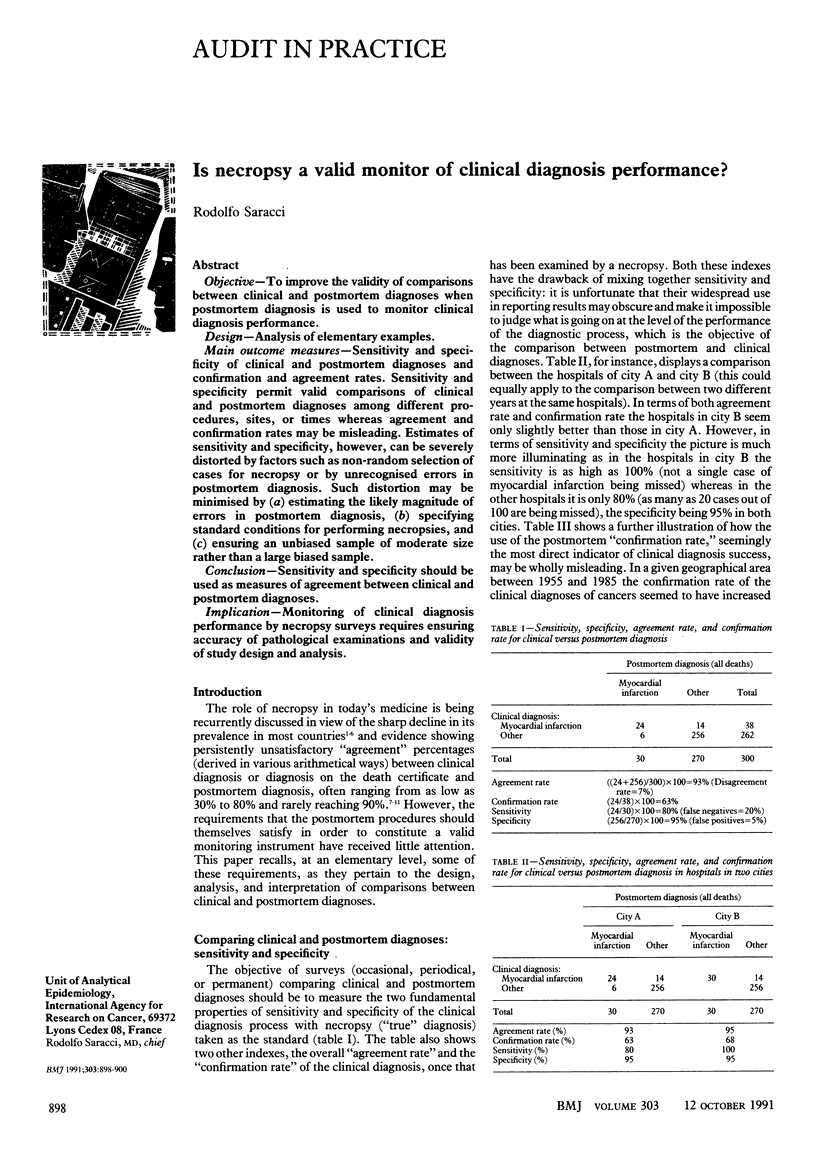Abstract
OBJECTIVE--To improve the validity of comparisons between clinical and postmortem diagnoses when postmortem diagnosis is used to monitor clinical diagnosis performance. DESIGN--Analysis of elementary examples. MAIN OUTCOME MEASURES--Sensitivity and specificity of clinical and postmortem diagnoses and confirmation and agreement rates. Sensitivity and specificity permit valid comparisons of clinical and postmortem diagnoses among different procedures, sites, or times whereas agreement and confirmation rates may be misleading. Estimates of sensitivity and specificity, however, can be severely distorted by factors such as non-random selection of cases for necropsy or by unrecognised errors in postmortem diagnosis. Such distortion may be minimised by (a) estimating the likely magnitude of errors in postmortem diagnosis, (b) specifying standard conditions for performing necropsies, and (c) ensuring an unbiased sample of moderate size rather than a large biased sample. CONCLUSION--Sensitivity and specificity should be used as measures of agreement between clinical and postmortem diagnoses. IMPLICATION--Monitoring of clinical diagnosis performance by necropsy surveys requires ensuring accuracy of pathological examinations and validity of study design and analysis.
Full text
PDF


Selected References
These references are in PubMed. This may not be the complete list of references from this article.
- Ahronheim J. C., Bernholc A. S., Clark W. D. Age trends in autopsy rates. Striking decline in late life. JAMA. 1983 Sep 2;250(9):1182–1186. [PubMed] [Google Scholar]
- Burrows S. The postmortem examination. Scientific necessity or folly? JAMA. 1975 Aug 4;233(5):441–443. [PubMed] [Google Scholar]
- Cameron H. M., McGoogan E., Clarke J., Wilson B. A. Trends in hospital necropsy rates: Scotland 1961-74. Br Med J. 1977 Jun 18;1(6076):1577–1580. doi: 10.1136/bmj.1.6076.1577. [DOI] [PMC free article] [PubMed] [Google Scholar]
- Cameron H. M., McGoogan E., Watson H. Necropsy: a yardstick for clinical diagnoses. Br Med J. 1980 Oct 11;281(6246):985–988. doi: 10.1136/bmj.281.6246.985. [DOI] [PMC free article] [PubMed] [Google Scholar]
- Goldman L., Sayson R., Robbins S., Cohn L. H., Bettmann M., Weisberg M. The value of the autopsy in three medical eras. N Engl J Med. 1983 Apr 28;308(17):1000–1005. doi: 10.1056/NEJM198304283081704. [DOI] [PubMed] [Google Scholar]
- Kircher T., Nelson J., Burdo H. The autopsy as a measure of accuracy of the death certificate. N Engl J Med. 1985 Nov 14;313(20):1263–1269. doi: 10.1056/NEJM198511143132005. [DOI] [PubMed] [Google Scholar]
- Peacock S. J., Machin D., Duboulay C. E., Kirkham N. The autopsy: a useful tool or an old relic? J Pathol. 1988 Sep;156(1):9–14. doi: 10.1002/path.1711560105. [DOI] [PubMed] [Google Scholar]
- Roberts W. C. The autopsy: its decline and a suggestion for its revival. N Engl J Med. 1978 Aug 17;299(7):332–338. doi: 10.1056/NEJM197808172990704. [DOI] [PubMed] [Google Scholar]
- Silvestri F., Bussani R., Giarelli L. High autopsy rate in Trieste, 1901-1985: age associated increase in necroscopy practice. Pathologica. 1988 Sep-Oct;80(1069):523–532. [PubMed] [Google Scholar]
- Sternby N. H. The role of autopsy in cancer registration in Sweden, with particular reference to findings in Malmö. IARC Sci Publ. 1991;(112):217–222. [PubMed] [Google Scholar]
- UEMURA K., STERNBY N., VANECEK R., VIHERT A., KAGAN A. GRADING ATHEROSCLEROSIS IN AORTA AND CORONARY ARTERIES OBTAINED AT AUTOPSY: APPLICATION OF A TESTED METHOD. Bull World Health Organ. 1964;31:297–320. [PMC free article] [PubMed] [Google Scholar]


